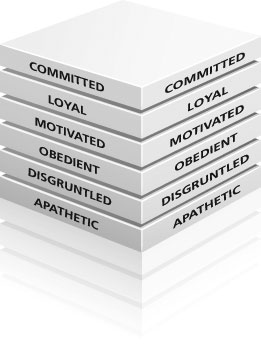What’s the Temperature of Your Workforce?
The stages of employee satisfaction, ranging from commitment to apathy, are as follows:
 Committed. Every organization wants to strive for committed employees. These individuals have moved beyond loyalty. They are so deeply moved by the organization’s values and purpose that they continually look for creative and innovative new ways for the organization to grow and develop. Their excitement, with its passion and sense of ownership, spills over onto others.
Committed. Every organization wants to strive for committed employees. These individuals have moved beyond loyalty. They are so deeply moved by the organization’s values and purpose that they continually look for creative and innovative new ways for the organization to grow and develop. Their excitement, with its passion and sense of ownership, spills over onto others.
Loyal. These are employees who enjoy coming to work, believe that they are making meaningful contributions, acknowledge that they are fairly recognized and rewarded, but most of all care deeply about the organization. Loyalty, however, does not always encourage creative and independent thinking, stimulate initiative, or instill a sense of ownership.
Motivated. Management is doing a good job of keeping these employees happy. They are content with their present situation, but that feeling may be temporary. The things that motivate them today may be taken for granted tomorrow. At this stage, an individual may also care more about personal than organizational success. The result is that a better offer may be tempting.
Obedient. These employees do enough to get by. Whether they are acting out of fear or trying to avoid personal conflict, they are unwilling to do anything that would set them apart. They are good soldiers who follow orders, but they have little interest in doing anything to make the organization more successful.
Disgruntled. These individuals’ hopes, desires, and expectations are not being met. However, they still care enough to try to change the situation by voicing their discontent. They demonstrate their displeasure by telling you that they’ll do something “as soon as they can get to it.” If you’re listening carefully, you will know something is bothering them. If you don’t catch the signals they’re sending, they will either reach their limit and leave the organization or become apathetic.
Apathetic. These employees are commonly known as deadwood. Their behavior can be characterized as having a lack of interest and/or caring. They sit at their desks shuffling papers and watching the clock; they take every sick and personal day allowed. They never make a suggestion or volunteer for anything. They accept assignments and deadlines with little visible reaction and respond with a shrug when asked if there is a problem. This general air of lassitude and disaffection is as contagious as enthusiasm in an organization.
The obvious question is, “How do you inspire employee commitment?”
Additional Reading:
Rewarding Today’s New Breed of Employee
The Costs of Mistreating Employees
9 Rules For a Great Recognition Program
If you like this poster, subscribe to our blog so that you don’t miss a single post. Get future posts by RSS feed, email or Facebook. It’s FREE. Click your favorite option (top right).






I have a complementary view of employee engagement which may interest you and your readers: Stakeholder Engagement Infographic at http://acuityconsultants.com/wp/2012/06/stakeholder-engagement-spectrum-infographic/
This contains drivers for and against stakeholder/employee engagement. For example, FOR: sponsorship, involvement, communication, readiness, responsibility. Further details can be found by following the links.
Very interesting post Tony. Thanks so much for sharing it with us.
Have a wonderful day!
Frank
After rereading this post for a 3rd time, I am convinced that employers who use people assessment tools at the supervisor & manager levels can anticipate & respond to workplace conflict and communication issues beforehand. Just reading the context of the various attitudes & behaviors reminded me of how workplaces are veritable melting pots better managed by leadership having some awareness of employee engagement issues. Another example of a post that offers valuable thought in helping me stay aware.
Thanks so much for your thoughts Felix.
I’m so glad that you find this a useful tool for management. I also believe that it can be used as a self-assessment tool.
Have a wonderful day! (And, thanks again for dropping by)
Best,
Frank
I have used the 6-stage commitment cube some time ago for some papers… today i am writing my thesis and despite I have changed my topic (jt was commitment before), I have just come again to this cube…. Mr. Sonnenberg, I love your cube. Please, write a post on what are your ideas on how to move the employee from one level to the other….
I assume that a Christian organizations are the ones who have the most committed workforce. Why? Because personal and organizational values are aligned. Even more if the employee has experimented the call to pursue the institutional mission (education, health, etc).
All the best!
Hi Christina
Thanks for your kind words. I’m glad you like the commitment cube 🙂
I’ve written two articles that may be of help to you. They are: “5 Qualities of Great Leaders” and “Counterfeit Leadership.” While they don’t address the cube directly, they do address leadership excellence. Here are the links for your convenience.
5 Qualities of Great Leaders
Counterfeit Leadership.
Thanks for taking the time to write.
Best,
Frank